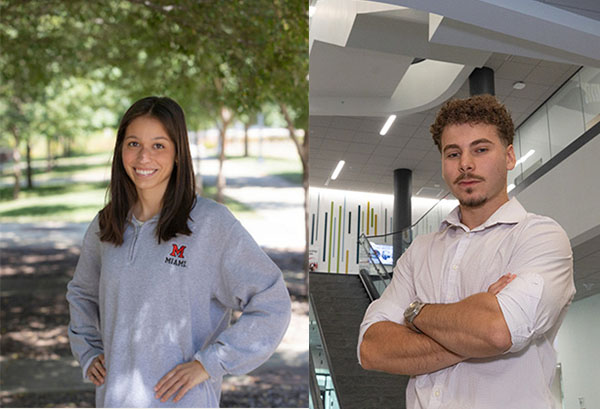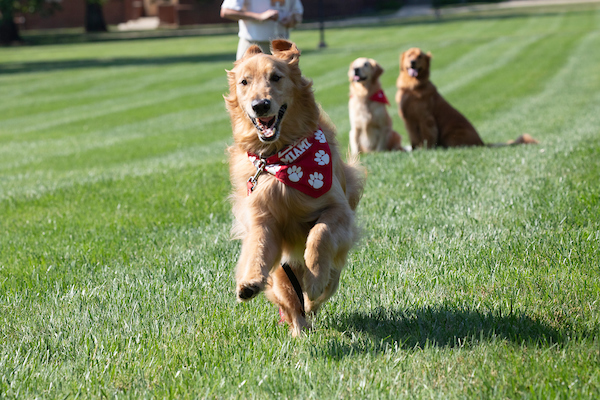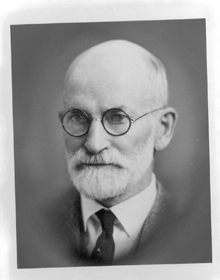

Department of Physics
The Department of Physics is dedicated to teaching and scholarship, with an emphasis on achieving close student-faculty relationships. With a versatile degree program and interdisciplinary research, we prepare students for advanced study or employment in physics, biological physics, applied physics, and related fields.
Welcome: Director of Instructional Labs
"While pursuing my graduate studies, I was always drawn to the academic world. I fondly remember the two years I spent here in the physics department earning my Master's degree. From my time in the research lab probing the behavior of cold atoms to the insightful classes and guidance of the excellent faculty, I cherish the growth I experienced here. It is truly a coincidence, and a wonderful one at that, to find myself returning to Miami University! It is an honor and a privilege to serve as the physics department's new Director of Instructional Labs. I look forward to embarking on this new chapter of my life in a place I have already grown to love."
– Ian Dilyard
Physics Major Awarded Provost's Student Academic Achievement Award
Congratulations to physics, computer science & mathematics triple major, Chanakya Pandya, who has been awarded a 2024 Provost's Student Academic Achievement Award. Miami's top award for academic achievement! Chanakya was nominated by, and conducts research in, Dr. Samir Bali's lab. This is the third year in a row a physics major has been selected as a PSAAA winner and highlights the quality of students in our department and the wonderful research mentoring they receive.
PSAAA InformationGraduate Student Application is Now Open
Apply NowFaculty Bali and Mirza Awarded NSF Grant
Congratulations to Drs. Samir Bali and Imran Mirza for the funding of their NSF proposal, "ExpandQISE: Track 1: Bright Highly Polarization-Squeezed Light Beam for Quantum Metrology." The ExpandQISE program aims to increase research capacity and broaden participation in Quantum Information Science and Engineering (QISE) and related disciplines through the creation of a diversified investment portfolio in research and education that will lead to scientific and engineering breakthroughs, while securing a talent pipeline in a field where workforce needs of industry, government and academia continue to outgrow the available talent.
Samir and Imran were awarded $796,516.00, amazing news!
Read moreGraduate Student Price Wins Best Poster at AVS Ohio Conference
Nate Price won a best poster and cash award at the AVS (American Vacuum Society) Ohio Chapter held at Ohio State University. Nate presented his work on quantum materials and his advisor is Dr. Perry Corbett.
In Dr. Corbett's words, "way to slay, Nate!"
Faculty Blue Announced as an AAPT Fellow
Dr. Jennifer Blue has been elected as an American Association of Physics Teachers Fellow for her exceptional contribution to AAPT's mission, to enhance the understanding and appreciation of physics through teaching. Fellowship is a distinct honor signifying recognition by one's professional peers.
Learn More`All About Resolution ' When it Comes to Donated STM
Scanning tunneling microscope (STM) in Perry Corbett's Physics lab is part of an educational partnership agreement between Miami and the Air Force Research Laboratory.
Learn MoreWomen in Physics Gather at Lewis Place
The WiP (Women in Physics) group got together for their annual dinner with Renate Crawford, who hosted the meal at Lewis Place, where they had great food and excellent conversation.
Thank you, again!
Physics Major Pandya Named as a 2024 Goldwater Scholar
Physics, computer science & mathematics triple major, Chanakya Pandya, was selected among 438 students nationwide to receive the scholarship, the premier undergraduate award for students intending a research career in mathematics, natural sciences, and engineering.
Learn more about the 2024 Goldwater ScholarsOur Programs
Physics in the News

Cleveland Clinic internships provide valuable experience for two Miami University students
Experience included work on quantum computer, multiple sclerosis research

The Crawfords welcome third golden retriever, Charlie, to family
They fostered the ‘big bundle of enthusiastic love’ before adopting

Quantum leap
Miami student taking quantum computing by storm, helping university to lead in cutting-edge field
Our Upcoming Seminars and Events
Our Mission
The Department of Physics is dedicated to teaching and scholarship, with an emphasis on achieving close student-faculty relationships. Our goals are to provide a rigorous grounding in the scientific process and a firm scientific understanding of the world, to foster critical thinking and to provide scientifically literate, liberally educated citizens through service and liberal education courses. We provide undergraduate and graduate majors with solid preparation in the discipline for advanced study or employment. Our scholarship should be inclusive, bringing faculty, graduate students, and especially undergraduates into participation in the joy of learning at the frontiers of human intellectual endeavor.
The primary functional aspects of our mission can be classified as:
- Educating and preparing students in our undergraduate majors programs for advanced study and/or employment following their graduation from Miami University.
- Serving as a major contributor to the scientific and technological literacy of students through participation in the implementation of the Miami Plan.
- Providing the knowledge, laboratory experience, and training in analytical reasoning and critical thinking required as the basis for advanced study for students majoring in other fields of science, mathematics, and engineering.
- Developing the skills in basic physical science of present and future teachers in elementary and secondary schools, and providing opportunities for continuing education of the public of our region and nation.
- Extending the expertise and competence in physics of our graduate students to prepare them for advanced study in the physical sciences and/or engineering or for employment.
- Engaging in scholarly activity that will extend the base of human knowledge through research and enhance the educational aspects of the Department's mission.
Our History

Miami Physics has its origins in the departments of natural philosophy (1832-45) and natural science (1845-73). The Physics and Chemistry Department was formed in 1885 under the leadership of Henry Snyder, and from 1898 to 1902, Raymond Hughes led the department, after which he went on to become Miami’s 15th president and Iowa State University’s 8th president. In 1903, the Physics Department was formed with Joseph Culler as chairman and the only full-time faculty member.
In 1926, Ray L. Edwards was named chair of physics, a position he held until 1956. During his 30-year tenure, the department grew with the addition of professors Dave Griffing, John Snider, George Arfken, Phil Macklin, Don Kelly, Joe Priest, Jim Poth, and Glenn Julian. Our Master’s program preceded the establishment of Miami’s Society of Physics Students Chapter in 1932, with several physics graduate students among the inaugural inductees.
During Dr. Edwards tenure, the department was located in Hughes Hall (which was renamed Kreger Hall in 1968). In 1961, Culler Hall was built specifically for the Physics Department, although it shared some of the space with Math, and later, Aeronautics. In 2014, the department moved back to a totally renovated Kreger Hall, complete with state-of-the-art teaching and research facilities, and common spaces for study and collaboration.
Miami Physics has a history of excellence in teaching, scholarship and leadership in physics education. In 1945, the prestigious Oersted Medal was awarded to Ray Edwards for notable contributions to the teaching of physics. Our faculty have published numerous texts, including Arfken’s world-renowned “Mathematical Methods for Physicists”; Priest’s “Energy: Principles, Problems and Alternatives”; Griffing’s “The Dynamics of Sports”; Kelly’s “Thermodynamics and Statistical Physics”; Arfken, Griffing, Kelly and Priest’s “University Physics”; and Paul DeVries’ “A First Course in Computational Physics”. The late Jim Poth and Beverley Taylor have been leaders at the state and national levels in physics education. Taylor was named both an APS Fellow and an AAPT Fellow in recognition of her contributions in that area.
Give to the Physics Department
Help us prepare the next generation of leaders—and our society as a whole. We have numerous scholarships, grants, and programs accepting contributions from donors like you.
